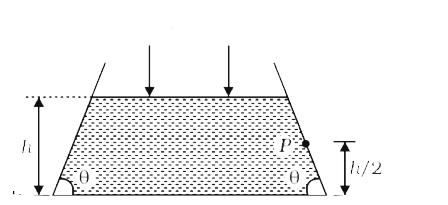The density of a metal at normal pressure is ρ. Its density when it is subjected to an excess pressure p is ρ' . If B is the bluk modulus of the metal, then find the ratio ρ'/ρ.
11−pB
1+BP
11−BP
1+pB
The correct Answer is:A
To find the ratio of the densities ρ′ρ of a metal under normal pressure and under excess pressure p, we can follow these steps:
Step 1: Understand the relationship between density and volume
Density ρ is defined as mass per unit volume:
ρ=mV
where m is the mass and V is the volume.
Step 2: Establish the relationship between densities
When the metal is subjected to an excess pressure p, its density changes to ρ′. The mass m remains constant, so we can express the new density as:
ρ′=mV′
where V′ is the new volume after applying the pressure.
Step 3: Relate the volumes
Since the mass is constant, we can write:
ρ′ρ=VV′
Step 4: Use the definition of bulk modulus
The bulk modulus B is defined as:
B=−pdVV
where dV is the change in volume. Rearranging gives:
dVV=−pB
This means that the new volume V′ can be expressed as:
V′=V(1−pB)
Step 5: Substitute the new volume into the density ratio
Substituting V′ into the density ratio gives:
ρ′ρ=VV(1−pB)=11−pB
Step 6: Final expression for the density ratio
Thus, the ratio of the densities can be expressed as:
ρ′ρ=11−pB
Conclusion
The final result for the ratio of densities under normal and excess pressure is:
ρ′ρ=11−pB
---
Density ρ is defined as mass per unit volume:
ρ=mV
where m is the mass and V is the volume.
When the metal is subjected to an excess pressure p, its density changes to ρ′. The mass m remains constant, so we can express the new density as:
ρ′=mV′
where V′ is the new volume after applying the pressure.
Since the mass is constant, we can write:
ρ′ρ=VV′
The bulk modulus B is defined as:
B=−pdVV
where dV is the change in volume. Rearranging gives:
dVV=−pB
This means that the new volume V′ can be expressed as:
V′=V(1−pB)
Substituting V′ into the density ratio gives:
ρ′ρ=VV(1−pB)=11−pB
Thus, the ratio of the densities can be expressed as:
ρ′ρ=11−pB
The final result for the ratio of densities under normal and excess pressure is:
ρ′ρ=11−pB
Topper's Solved these Questions
- BOOK - DC PANDEY ENGLISHCHAPTER - ELASTICITYEXERCISE - Match the columns4videos
ELASTICITY
- BOOK - DC PANDEY ENGLISHCHAPTER - ELASTICITYEXERCISE - Medical entrances s gallery21videos
ELASTICITY
- BOOK - DC PANDEY ENGLISHCHAPTER - ELASTICITYEXERCISE - Check point 12.315videos
ELASTICITY
- BOOK - DC PANDEY ENGLISHCHAPTER - CURRENT ELECTRICITYEXERCISE - All Questions469videos
CURRENT ELECTRICITY
- BOOK - DC PANDEY ENGLISHCHAPTER - ELECTROSTATICSEXERCISE - Integer17videos
ELECTROSTATICS
Similar Questions
Knowledge Check
- Question 1 - Select One
The pressure inside a liquid of density ρ at a depth h is :
AhρgBhρgChρgDhρ - Question 2 - Select One
The pressure at depth h below the surface of a liquid of density ρ open to the atmosphere is
Agreater than the atmospheric pressure by ρghBless than the atmospheric pressure by ρghCequal to the atmospheric pressureDincreases exponentially with depth - Question 3 - Select One
The density of water at the surface of ocean is ρ . If the bulk modulus of water is B, then the density of ocean water at depth, when the pressure at a depth is αp0 and p0 is the atmospheric pressure is
AρKk−nP0BρKK+nP0CρKK−(n−1)P0DρK(K+(n−1)P0)
The density of the given gas at constant pressure and temperature is ρ and its rate of diffusion isr. If density of the gas becone ρ/3 then rate of diffusion becomes
View SolutionThe pressure (p) and the dencity ρ of given mass of a gas expressed by Boyle's law, p=Kρ holds true.
View SolutionDuring adiabatic process pressure (p) versus density (ρ) equation is
View SolutionA ball of density ρ0 falls from rest from a point P onto the surface of a liquid of density ρ in the time T. It enters the liquid, stops, moves up, and returns to P in a total time 3 T. neglect viscosity, surface tension and splashing find the ratio of ρρ0
View SolutionA container (see figure) contains a liquid upto a height h. The density of the liquid is The gauge pressure at point P is ρghx. Find the value of x
 View Solution
View Solution

